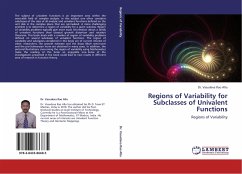
Univalent Function
Versandkostenfrei!
Versandfertig in 6-10 Tagen
19,99 €
inkl. MwSt.

PAYBACK Punkte
10 °P sammeln!
High Quality Content by WIKIPEDIA articles! In mathematics, in the branch of complex analysis, a holomorphic function on an open subset of the complex plane is called univalent if it is one-to-one. Any mapping a of the open unit disc to itself, :phi_a(z) =frac{z-a}{1 - bar{a}z}, where a le 1, is univalent. One can prove that if G and are two open connected sets in the complex plane, and f: G to Omega is a univalent function such that f(G) = (that is, f is onto), then the derivative of f is never zero, f is invertible, and its inverse f 1 is also holomorphic. More, one has by the chain rule (f^...
High Quality Content by WIKIPEDIA articles! In mathematics, in the branch of complex analysis, a holomorphic function on an open subset of the complex plane is called univalent if it is one-to-one. Any mapping a of the open unit disc to itself, :phi_a(z) =frac{z-a}{1 - bar{a}z}, where a le 1, is univalent. One can prove that if G and are two open connected sets in the complex plane, and f: G to Omega is a univalent function such that f(G) = (that is, f is onto), then the derivative of f is never zero, f is invertible, and its inverse f 1 is also holomorphic. More, one has by the chain rule (f^{-1})'(f(z)) = frac{1}{f'(z)} for all z in G. For real analytic functions, unlike for complex analytic (that is, holomorphic) functions, these statements fail to hold. For example, consider the function f: (-1, 1) to (-1, 1) given by f(x) = x3. This function is clearly one-to-one, however, its derivative is 0 at x = 0, and its inverse is not analytic, or even differentiable, on the whole interval ( 1,1).












